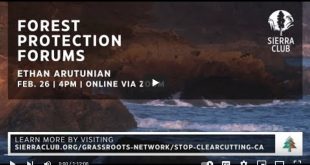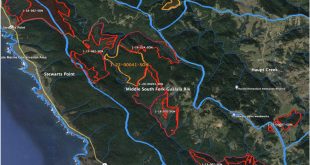| Examples of riparian strips being maintained as a condition of approval for timber harvest plans adjacent to the riparian buffer of the Gualala River and its tributaries:
THP 1-97-392 (Buckwheat): “Timber harvest plans in the recent past have not had trees removed from the WLPZs [watercourse and lake protection zone – essentially a riparian strip or buffer] where such removal could lead to reduced shade canopy.” – memo 10/10/97 to Glen Newman from the Department of Forestry (CDF). THP 1-97-477 (Rockeye): As a result of the designation of coho as an endangered species, additional mitigations were deemed necessary for the Class I WLPZ. The shade canopy protection for the 1st 25 feet of the Class I was increased to 85% of canopy retention and the rest of the WLPZ increased to 70%. The mitigations were incorporated to “protect [coho] habitat from siltation, loss of woody debris, and temperature increases resulting from removal of canopy cover.” (John Williams letter to Dennis Hall – CDF in response to pre-harvest inspection). THP 1-96-276 (German Rancho 96): The registered professional forester for the German Rancho plan states the large woody debris recruitment near watercourses will be from streamside conifers and hardwoods which would be retained in the WLPZs. THP 1-96-373 (Powerline): In a memo from the Department of Forestry to Glen Newman, “The WLPZ areas of cable class I watercourses were examined where the RPF [registered professional forester] had noted the reduction in zone width allowed for cable operations on steep slopes. Although the RPF had noted this would be done, the zone maintained a 100-150+ WLPZ in the steeper areas. The zone in the less steep areas was also generously flagged to provide an adequate buffer. The Class I watercourse, Rockpile and Buckeye Creeks, are both believed to have warm water temperatures that could act to reduce the aquatic habitat quality in those streams. This office has asked for WLPZ no-cuts on THPs in these drainages for about 2-3 years.” “Because the proposed harvest plan may be within the ranges of several species which have been listed as threatened under the Endangered Species Act, including the Central California Coast Steelhead, Central California Coast coho, and California Coastal Chinook the protection of the WLPZ would seem ever more necessary. The Department of Fish and Game has also determined there is potential marbled murrelet habitat on and adjacent to the proposed THP. These areas of species recovery take precedent to the proposed timber management operations.” |
 Friends of Gualala River Protecting the Gualala River watershed and the species living within it
Friends of Gualala River Protecting the Gualala River watershed and the species living within it


